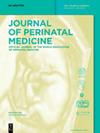Association between aneuploidy screening analytes and adverse outcomes in twin gestations
IF 1.7
4区 医学
Q3 OBSTETRICS & GYNECOLOGY
引用次数: 0
Abstract
Objectives To evaluate associations between serum analytes used for genetic screening and obstetric complications among twin pregnancies. Methods This cohort included twins delivered at a tertiary care hospital from 2009 to 2017. Abnormal levels of pregnancy associated plasma protein (PAPP-A), first and second trimester human chorionic gonadotropin (hCG), alpha fetoprotein (AFP), estriol, and inhibin, reported as multiples of the median (MoM), were defined as <5 %ile or >95 %ile for our cohort. Associations between abnormal analytes and preterm delivery, small for gestational age, and pregnancy-associated hypertension were calculated using Fisher’s exact test. Results A total of 357 dichorionic/diamniotic and 123 monochorionic/diamniotic twins were included. Among dichorionic/diamniotic twins, elevated AFP (>3.70 MoM) was associated with increased preterm delivery <34 weeks (44.4 vs. 16.5 %, p=0.007), while elevated inhibin (>4.95 MoM) was associated with increased preterm delivery<37 weeks (94.1 vs. 58.8 %, p=0.004). For monochorionic/diamniotic twins, elevated inhibin (>6.34 MoM) was associated increased preterm delivery <34 weeks (66.7 vs. 24.8 %, p=0.04) and hypertension (66.7 vs. 21.4 %, p=0.03). Conclusions Selected abnormal analyte levels were associated with increased rates of adverse outcomes in twin pregnancies, which differed by chorionicity. Our findings assist providers in interpreting abnormal analyte levels in twin pregnancies and may help to identify those at increased risk for adverse outcomes.非整倍体筛查分析物与双胎妊娠不良结局之间的关系
目的 评估用于基因筛查的血清分析物与双胎妊娠产科并发症之间的关联。方法 该队列包括 2009 年至 2017 年在一家三级医院分娩的双胞胎。妊娠相关血浆蛋白(PAPP-A)、第一和第二孕期人绒毛膜促性腺激素(hCG)、甲胎蛋白(AFP)、雌三醇和抑制素的异常水平以中位数的倍数(MoM)报告,我们的队列将其定义为<5 %ile或>95 %ile。异常分析物与早产、胎龄小和妊娠相关高血压之间的关系采用费雪精确检验进行计算。结果 共纳入了 357 例二绒毛膜/羊膜双胎和 123 例单绒毛膜/羊膜双胎。在二绒毛膜/羊膜双胎中,甲胎蛋白(>3.70 MoM)升高与早产<34周(44.4% vs. 16.5%,p=0.007)增加有关,而抑制素(>4.95 MoM)升高与早产<37周(94.1% vs. 58.8%,p=0.004)增加有关。对于单绒毛膜/羊膜双胎,抑制素(>6.34 MoM)的升高与早产<34周(66.7% vs. 24.8%,p=0.04)和高血压(66.7% vs. 21.4%,p=0.03)的增加有关。结论 在双胎妊娠中,选定的异常分析物水平与不良结局发生率的增加有关,这与绒毛膜性有关。我们的研究结果有助于医疗服务提供者解释双胎妊娠中的异常分析物水平,并有助于识别不良结局风险增加的孕妇。
本文章由计算机程序翻译,如有差异,请以英文原文为准。
求助全文
约1分钟内获得全文
求助全文
来源期刊

Journal of Perinatal Medicine
医学-妇产科学
CiteScore
4.40
自引率
8.30%
发文量
183
审稿时长
4-8 weeks
期刊介绍:
The Journal of Perinatal Medicine (JPM) is a truly international forum covering the entire field of perinatal medicine. It is an essential news source for all those obstetricians, neonatologists, perinatologists and allied health professionals who wish to keep abreast of progress in perinatal and related research. Ahead-of-print publishing ensures fastest possible knowledge transfer. The Journal provides statements on themes of topical interest as well as information and different views on controversial topics. It also informs about the academic, organisational and political aims and objectives of the World Association of Perinatal Medicine.
 求助内容:
求助内容: 应助结果提醒方式:
应助结果提醒方式:


